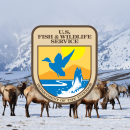States
WyomingADDITIONAL SHORT-TERM EXTENSION OF STEP-DOWN PLAN
In 2019, the National Elk Refuge (Refuge) finalized a Bison and Elk Step-Down Plan (Step-Down Plan) that authorizes and provides management direction for bison and elk on the Refuge. The Step-Down Plan expired at the end of the 2024. Currently, the U.S. Fish and Wildlife Service (Service) is continuing development of the draft Bison and Elk Management Plan (BEMP) and draft Environmental Impact Statement (EIS) to guide long-term management of bison and elk on the Refuge.
The Service already extended the Step-Down Plan through the end of 2025. However, the updated BEMP and EIS are taking longer to complete than anticipated due to ongoing discussions with our partners over long-term bison and elk management. Therefore, this additional short-term extension of the Step-Down Plan will provide the Service sufficient time to complete the BEMP and EIS. Additionally, this limited extension of the Step-Down Plan will continue to allow biologists from the Service and Wyoming Game and Fish Department to delay the initiation of supplemental feeding, deter elk from finding the feed grounds, and encourage elk to utilize native winter range. In addition, and in accordance with the Step-Down Plan, the Service will coordinate with WGFD to end feeding earlier in the season, thereby reducing the duration of supplemental feeding and encouraging elk on the Refuge to spread out and utilize natural food resources in an effort to reduce potential disease transmission.
This short-term extension of the Step-Down Plan is covered by the Service’s categorical exclusion 516 DM 8.5 A(1): “changes or amendments to an approved action when such changes have no or minor potential environmental impact.” A categorical exclusion is a category of actions that a federal agency has determined does not significantly impact the human environment and therefore does not need further analysis under the National Environmental Policy Act. You can read the documentation of the categorical exclusion here.
UpDATE: Bison and Elk Management Plan
To ensure long-term sustainability for Jackson bison and elk herds on the National Elk Refuge, the U.S. Fish and Wildlife Service has begun drafting an update to the previously adopted 2007 Bison and Elk Management Plan (BEMP) and associated Environmental Impact Statement (EIS), and the 2019 Step-down Plan, which expires in December 2024.
This update will provide long-term guidance and actions intended to reduce herd reliance on supplemental feeding and the total number of elk on the refuge over time, which will increase herd sustainability for the future. The updates include newly available scientific information and changed conditions since the original 2007 plan adoption, including the presence of Chronic Wasting Disease in the elk herd. The update will set new desired conditions, management goals, objectives, and strategies to guide future management of bison and elk on the refuge. Because the Jackson elk and bison herds migrate across several jurisdictional boundaries, the Service continues to work closely with Tribes, the National Park Service, U.S. Forest Service and Wyoming Game and Fish Department.
RECENT PUBLIC ENGAGEMENT OPPORTUNITIES
Public participation in our information-gathering process is critical for responsible decision-making. Our goal is to create opportunities for meaningful public engagement into decision-making by actively engaging diverse interests to obtain inclusive public feedback and the best available science (biological information, potential effects to the human environment, etc.) to inform the NEPA process.
- In August 2023, the Service opened a 30-day scoping period for the development of an updated BEMP and EIS. The documents associated with this announcement are in the Federal Register. During this scoping period, the Service took public comments and held public scoping meetings to provide interested stakeholders and members of the public an opportunity to learn more about the process, ask questions and provide feedback.
- In March 2024, the Service held additional engagement opportunities which included public information sessions and facilitated workshops.
- In May 2024, the Service hosted two public information sessions, one in-person plus a virtual session. A recording of virtual listening session is available to the public: Watch the recording on YouTube.
- Following the listening sessions, the Service held two half-day workshops for interested parties to further understand concerns, tradeoffs, and potential ways to reduce adverse consequences associated with potential management alternatives.
ADDITIONAL RESOURCES
National Elk Refuge Bison and Elk Management Plan Fact Sheet
2007 Bison and Elk Management Plan and Environmental Impact Statement
2019 Step-down Plan and Environmental Assessment
Chronic Wasting Disease Response Strategy.




